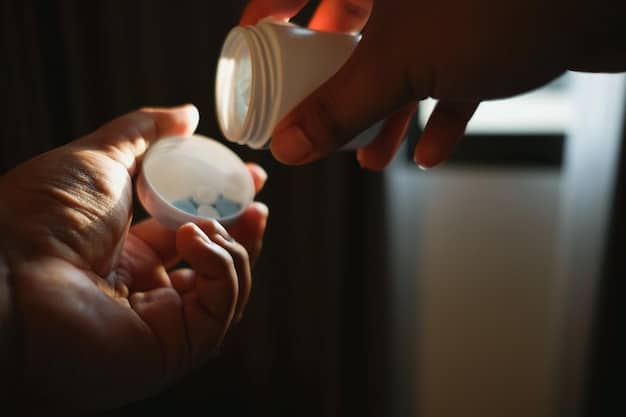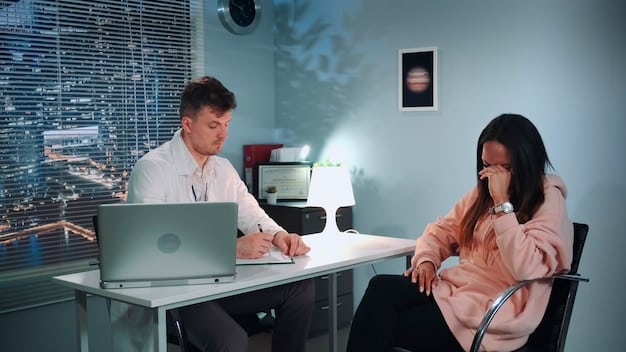Opioid Crisis in the US: Resources & Addiction Recovery Support

Understanding the opioid crisis in the US involves recognizing the scope of the problem and identifying available resources and support systems for addiction recovery, including treatment centers, support groups, and government assistance programs.
Navigating the landscape of the opioid crisis in the United States can be overwhelming, especially when seeking help for yourself or a loved one. This article provides a comprehensive overview of the issue, along with vital resources and support systems available for addiction recovery.
Understanding the Opioid Crisis: A National Health Emergency
The opioid crisis in the US has reached epidemic proportions, impacting communities across the nation. It’s crucial to understand the factors contributing to this crisis to address it effectively. This section will delve into the history, statistics, and drivers behind this national health emergency.
How the Opioid Crisis Started
The surge in opioid use began in the late 1990s when pharmaceutical companies marketed opioid painkillers aggressively, downplaying their addictive potential. This led to widespread prescriptions for chronic pain management, resulting in many individuals becoming dependent on these drugs.
Key Statistics on Opioid Use
According to the Centers for Disease Control and Prevention (CDC), opioids were involved in over 70,000 overdose deaths in 2022. This highlights the severity of the crisis and the urgent need for preventive measures and effective treatment options.
- Increased overdose deaths are a major concern.
- Rising rates of opioid use disorder (OUD) among young adults.
- Significant economic burden due to healthcare costs and lost productivity.
In conclusion, understanding the historical context and the statistical data surrounding the opioid crisis is essential for creating targeted, effective strategies to combat addiction and save lives.

Recognizing Opioid Addiction: Signs and Symptoms
Identifying opioid addiction early can significantly improve the chances of successful recovery. Recognizing the signs and symptoms is the first step in getting help. This section outlines the common indicators of opioid addiction.
Physical Signs of Addiction
Physical signs of opioid addiction can include constricted pupils, drowsiness, slurred speech, and decreased respiratory rate. These symptoms often become more pronounced as the addiction progresses.
Behavioral Indicators of Opioid Addiction
Behavioral indicators of opioid addiction may involve seeking prescriptions from multiple doctors, neglecting responsibilities, social isolation and experiencing mood swings. It’s important to note that individual behaviors can vary.
- Withdrawal Symptoms: Experiencing withdrawal symptoms like muscle aches, sweating, and anxiety when not using opioids.
- Craving for Opioids: An intense desire or craving to use opioids, often overriding other priorities.
- Changes in Social Behavior: Withdrawal from social activities and strained relationships with family and friends.
In summary, both physical and behavioral signs can indicate opioid addiction. Early recognition and intervention are crucial for improving recovery outcomes.
Available Resources for Addiction Recovery
Navigating the resources available for addiction recovery can be confusing. Knowing where to turn for help is vital for individuals and families affected by opioid addiction. This section compiles a list of resources designed to support addiction recovery.
Treatment Centers Offering Comprehensive Care
Treatment centers provide comprehensive care, including detoxification, therapy, and aftercare planning. These centers often offer a range of evidence-based treatments tailored to individual needs. Look for accredited facilities with experienced medical staff.
Support Groups for Individuals and Families
Support groups offer a safe and supportive environment where individuals and families can share experiences and receive encouragement. Groups like Narcotics Anonymous (NA) and Al-Anon provide valuable peer support.
- Access to Medical Professionals: Consultation with doctors and nurses who specialize in addiction treatment.
- Educational Resources: Information on addiction, treatment options, and relapse prevention.
- Family Support Programs: Resources and services designed to support families affected by addiction.
In conclusion, a variety of resources, including treatment centers and support groups, are available to help individuals and families navigate the path to addiction recovery.

Understanding Treatment Options for Opioid Addiction
Exploring the various treatment options available can empower individuals to make informed decisions about their recovery journey. This section provides an overview of effective treatment approaches and therapies.
Medication-Assisted Treatment (MAT)
MAT combines medications like buprenorphine or naltrexone with counseling and behavioral therapies. It is considered a highly effective approach for treating opioid addiction, helping to reduce cravings and withdrawal symptoms.
Behavioral Therapies for Addiction Recovery
Behavioral therapies, such as cognitive-behavioral therapy (CBT) and contingency management (CM), help individuals change harmful thought patterns and behaviors related to opioid use.
- Individual Counseling: One-on-one therapy sessions to address personal issues and develop coping strategies.
- Group Therapy: Group sessions that provide peer support and guidance.
- Holistic Approaches: Alternative therapies, such as yoga, meditation, and art therapy, that promote overall well-being.
In summary, a combination of medication-assisted treatment and behavioral therapies is often the most effective approach for addressing opioid addiction.
Preventing Opioid Overdose: Recognizing Symptoms and Using Naloxone
Knowing how to recognize and respond to an opioid overdose can save lives. This section provides critical information and resources for preventing opioid overdoses.
Recognizing the Signs of an Opioid Overdose
Signs of an opioid overdose include slow or shallow breathing, unresponsiveness, pinpoint pupils, and blue lips or skin. Recognizing these signs is crucial for acting quickly.
The Role of Naloxone in Reversing Overdoses
Naloxone, also known as Narcan, is a life-saving medication that can reverse the effects of an opioid overdose. It is available in nasal spray and injectable forms and can be administered by trained individuals.
- Training Programs: Courses and workshops that teach individuals how to administer naloxone.
- Access to Naloxone: Information on where to obtain naloxone kits in your community.
- Community Outreach: Initiatives that educate the public about overdose prevention and naloxone use.
In conclusion, being educated about the signs of an opioid overdose and having access to naloxone can significantly reduce the risk of fatal outcomes.
The Role of Community Support in Recovery Maintenance
Community support plays a fundamental role in sustaining long-term recovery. Having a strong support network can help individuals stay on track. This section explores how community support contributes to recovery maintenance.
Building a Supportive Network
Building a strong support network involves surrounding oneself with positive influences, including family, friends, and support groups. A robust network can provide motivation, encouragement, and accountability.
Maintaining Sobriety through Relapse Prevention Strategies
Relapse prevention strategies, such as identifying triggers and developing coping mechanisms, are essential for maintaining sobriety. Regular check-ins with therapists and support group meetings can reinforce these strategies.
- Aftercare Programs: Continued support and therapy after completing a treatment program.
- Sober Living Homes: Supportive residential environments for individuals transitioning from rehab.
- Engaging in Healthy Activities: Participating in activities that promote physical and mental well-being.
In summary, a supportive community and effective relapse prevention strategies are key components of long-term recovery from opioid addiction.
| Key Point | Brief Description |
|---|---|
| 💊 Understanding Opioid Crisis | Opioids are highly addictive and have led to a significant health crisis. |
| ❤️ Recognizing Addiction | Identifying physical and behavioral signs helps in early intervention. |
| 🚑 Accessing Resources | Treatment centers and support groups offer comprehensive support. |
| 💉 Preventing Overdose | Naloxone is life-saving medication can reverse the effects of an opioid overdose.. |
Frequently Asked Questions
▼
The opioid crisis began with aggressive marketing of prescription painkillers, leading to widespread prescriptions and subsequent addiction. The easy availability and high addictive potential of these drugs have fueled the crisis.
▼
Look for physical signs like constricted pupils and drowsiness, as well as behavioral changes like social withdrawal and neglecting responsibilities. A strong craving for opioids is also a key indicator.
▼
Treatment centers provide comprehensive care, including detox and therapy. Support groups like NA and Al-Anon offer peer support. Additionally, there are various educational resources and family support programs available.
▼
MAT combines medications like buprenorphine with counseling and behavioral therapies. It is highly effective in reducing cravings and withdrawal symptoms, making it a cornerstone of opioid addiction treatment.
▼
Naloxone is a medication that can quickly reverse the effects of an opioid overdose. Administering naloxone can restore normal breathing and consciousness, preventing fatal outcomes if given promptly.
Conclusion
In conclusion, understanding the opioid crisis involves recognizing its complexities and utilizing available resources for addiction recovery. By staying informed, seeking help, and supporting community efforts, we can make a collective impact on mitigating the opioid crisis in the US.





